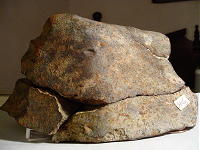by Robert Verish
![]()
by Robert Verish
Reclassification: Gold Basin shown to be L4-6

Since this month's topic has been the subject of several previous installments of "Bob's Findings" articles, this is more of an "Update". What has brought attention back to this subject is the publication of an abstract, and the results of a study that were presented at the Lunar and Planetary Science XXXVI (2005) Meeting (LPSC 2005). This poster presentation was titled:
"ATMOSPHERIC FRAGMENTATION OF THE GOLD BASIN METEOROID AS CONSTRAINED FROM COSMOGENIC NUCLIDES"
by Kees Welten, D. J. Hillegonds, A. J. T. Jull and David A. Kring
and this is the link to that abstract:
http://www.lpi.usra.edu/meetings/lpsc2005/pdf/2352.pdf
Among other things, this abstract concluded that:
"The radionuclide results in fifteen
new L chondrite specimens from the Gold Basin area
indicate that all samples are part of the same shower,
which should be classified as an L4-6 chondrite breccia."
That the L6 and the L4 chondrites from Gold Basin are from the same fall is not "news" to those who have closely followed this discussion ever since I first proposed this possibility over 4 years ago. In fact, I wrote an abstract on this very subject, for the LPSC 2001 Meeting (Lunar and Planetary Science XXXII). This print-only paper was titled:
"GOLD BASIN: OVERLAPPING STREWN FIELDS OR HETEROGENEOUS METEOROID?"
and this is the link to that abstract:
http://www.lpi.usra.edu/meetings/metsoc2001/pdf/5393.pdf
And if your Adobe Acrobat has trouble reading that .PDF web page, then here is the same abstract in a webpage format that your browser should have no trouble reading:
My abstract was written soon after the name "Hualapai Wash" was approved for an L6 stone found at Gold Basin. But this name approval was before there was an appreciation for the variability of the Gold Basin meteorite. It was just assumed that, if it wasn't an L4, it had to be another meteorite. In my abstract I posed the question of whether Gold Basin could be both L4 and L6, and everything in between! The following are links that take you to my previous "Bob's Findings" articles on this subject:
May 2002 - In this article I concluded that Gold Basin should be reclassified as an L4-6.
June 2002 - This article has a lot of images of "Gold Basin Area" meteorites.
So, this installment of Bob's Findings isn't so much of an "Update", as it is more of a "Verification" - reporting on a recent abstract that gives supporting evidence for the reclassification of the Gold Basin meteorite. To be accurate, this recent abstract said that the three specimens (that I supplied to the researcher) of L6 chondrites classified by UCLA are from the Gold Basin (L4-6) meteorite fall. This means that only those 3 are proven to be paired, and that it can't be assumed the other Hualapai Wash stones are paired, as well, without additional testing. Images of these Gold Basin L6 stones that samples were taken from for use in this radioisotope study are depicted below:
 Hualapai Wash 013 v. Gold Basin L6 - this meteorite is CLASSIFIED as:
Hualapai Wash 013 v. Gold Basin L6 - this meteorite is CLASSIFIED as:
L6, S4, W5 (Fa 23.8+/-0.4%)
 Hualapai Wash 010 v. Gold Basin L6 - this meteorite is CLASSIFIED as:
Hualapai Wash 010 v. Gold Basin L6 - this meteorite is CLASSIFIED as:
L6, S4, W1 (Fa 24.6+/-0.5%)
 Hualapai Wash 002 v. Gold Basin L6 - this meteorite is CLASSIFIED as:
Hualapai Wash 002 v. Gold Basin L6 - this meteorite is CLASSIFIED as:
L6, S5, W3 (Fa 24.1+/-0.4%)
Several other Hualapai Wash nnn (Gold Basin L6) classified stones were submitted to these same researchers, but they were not used in their study. Images of these stones that samples were taken from, but not used, are depicted below:
 Hualapai Wash 011 v. Gold Basin L6 - this meteorite is CLASSIFIED as:
Hualapai Wash 011 v. Gold Basin L6 - this meteorite is CLASSIFIED as:
L6, S4, W1 (Fa 24.0+/-0.3%)
 Hualapai Wash 012 v. Gold Basin L6 - this meteorite is CLASSIFIED as:
Hualapai Wash 012 v. Gold Basin L6 - this meteorite is CLASSIFIED as:
L6, S4, W3 (Fa 24.2+/-0.2%)
In addition to the above stones, a sample of an unclassified "Gold Basin Area" stone from the very northern end of the strewn field was submitted to these same researchers and was used in their study. The results of this radioisotope study suggest that either (1) a 3m meteoroid produced the Gold Basin strewn field in a single fragmentation event, or (2) "that a large interior fragment of an object 4-5 m in radius survived the initial atmospheric fragmentation event and landed (in one or more pieces) outside the boundaries of the presently known strewnfield." If the latter is the case, then searchers should look in southern Nevada for a meteorite like the one depicted below:
 Gold Basin (L4) v. Gold Basin (L4-6) - this meteorite is UNCLASSIFIED.
Gold Basin (L4) v. Gold Basin (L4-6) - this meteorite is UNCLASSIFIED.
NOTE: ONLY CLASSIFIED stones can be called "Gold Basin (L6)"
Not all L6 meteorites that have been found in the Gold Basin strewn field are paried to that fall! Here is a link to some images of a 3.4+kg fractured stone that [was still pending nomenclature approval at the time this article was originally published, but has since been given the formally approved name, "Bluebird"]. Samples of this meteorite were turned down by the researchers in their radioisotope study because it was considered to be "too young"!:

 Bluebird - this meteorite is CLASSIFIED as:
Bluebird - this meteorite is CLASSIFIED as:
More about the Bluebird (L6), a "new" Arizona meteorite, in a future Bob's Findings article.
My previous articles can be found *HERE*
The topic of my next article is about meteorites that will be appearing in this year's Meteoritical Bulletin #89.
My other articles can be found *HERE*
For for more information, please contact me by email:
Bolide*chaser
